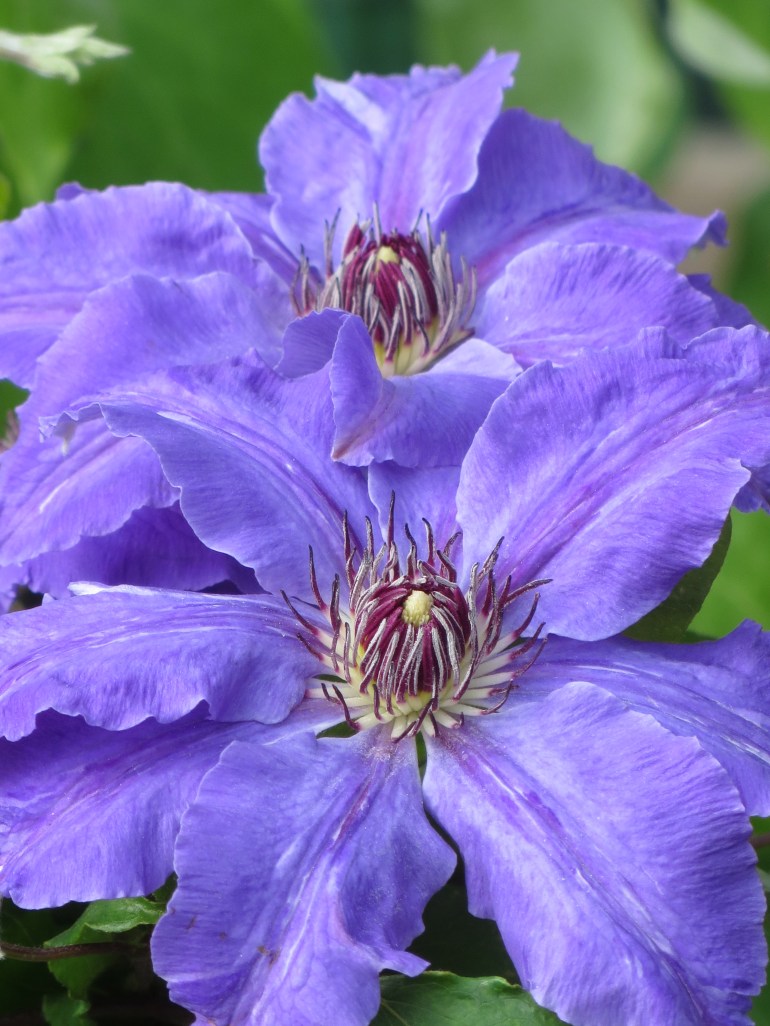Rebecca, a Raymond Evison clematis (The Chelsea feature for 2008 and named after Raymond Evison’s eldest daughter. Clematis Rebecca has stunning large red flowers and flowers freely over a long season.)
Today I have mostly been working with, and reading this evening about, clematis.
The large, summer flowering varieties are coming into bloom in a dazzling kaleidoscope of colour, taking over from the evergreen armandii with blizzard-white show, the vigorous tree-scrambling montanas in (mostly) soft pinks and the delicate pixy-hats of the Alpinas and Macropetalas (whites, pinks, creams, purples and blue).
Clematis Liberation, Raymond Evison clematis (Evifive)
Clematis can bring colour and interest to our gardens virtually every day of the year. Various distinctions are made to make the selection, care, pruning and garden-use consistent. For example, large-flowered types, both early (e.g. Nelly Moser) and late-blooming (e.g. Jackmanii); and small-flowered clematis which can be subdivided into at least ten further groupings –
- Early flowering Evergreen (C. armandii),
- Alpina (C. alpina Francis Rivis)
- Macropetala (C macropetala Markham’s Pink)
- Montana (C. montana Mayleen)
- Rockery Groups (C. cartmanii Joe) and the later flowering
- Herbaceous (C. integrifolia Rosea)
- Viticellas (C. viticella Mme Julia Correvon)
- Texensis (C. texensis Gravetye Beauty)
- Orientalis (C. orientalis Bill Mackenzie and
- Late Species Groups (C. flammula)
Clematis Edouard Desfosse (‘Only moderate vigour. Leaves simple or ternate. Flowers 15cm across. Sepals 8, long, rather gappy; deep mauve-purple, fading. Reddish-purple central bar. Conspicuous reddish-purple anthers.’ Christopher Lloyd)
The rose and the clematis make excellent companions, the King and Queen of Climbers and every Rosarian and Clematarian should read John Howells’ excellent book ‘The Rose and the Clematis as good companions.‘ A veritable bible on both genus and the matches that can be made between them both, extending the season front and back and making great compositions together.
Clematis Niobe (‘For once an attractively and appropriately named new clematis’ (Christopher Lloyd/Tom Bennet 1989). ‘The one thing everyone remembers about ‘Niobe’ is that she was ‘all tears’. Sepals, 6. Lovely, very deep, velvety red. Lighter, greenish stamens’. From John Howells’ book, ‘Velvety ruby-red tepals and golden stamens. Almost black when it first opens. Flowers continuously. Pruning optional. Competes with ‘Rouge Cardinal’ as the best red. Vigorous to 8′ (2.56m). Outstanding’)
John Howells’ book has comprehensive details on both rose and clematis, strong recommendations for partnerships and superb photography.
Clematis Lasurstern (‘Fairly vigorous to 3m. Leaves sometimes simple, usually ternate. Flowers 15-18cm wide, opening perfectly flat. Sepals 7 or 8 with wavy margins, tapering to fine points. Rich, deep blue fading to campanula blue. Greenish-white bar on under surface. Stamens pale creamy. Second crop flowers only 13 cm across.’ Christopher Lloyd)
I would also recommend Christo Lloyd’s book too, simply titled Clematis (my edition 1989, revised with Tom Bennett and still remarkably comprehensive) for excellent warts and all descriptions and some shining examples of his wry, dry and acerbic wit. Read the end section ‘Names: their spelling and pronunciation‘ so as to avoid falling foul of his mischievous spirit.
Clematis Diamantina, Raymond Evison clematis (Evipo039 (Launched at the Chelsea Flower Show 2010, clematis Diamantina is an exceptional, free-flowering clematis with 4-6 inch pom pom like blue double flowers, each lasting up to 4 weeks. Repeat flowering throughout summer.)
One luminary of the clematis world I would do well to recommend is Raymond Evison – his nursery website is at
http://www.raymondevisonclematis.com/main/home.asp?a=1
for further details of his extraordinary creations, some of which are pictured above.






